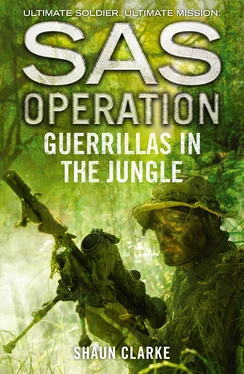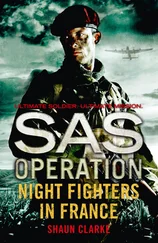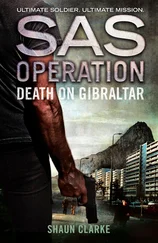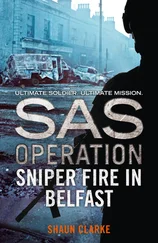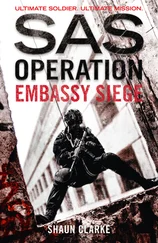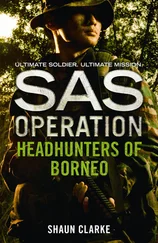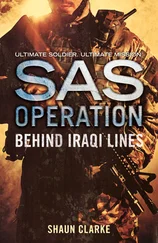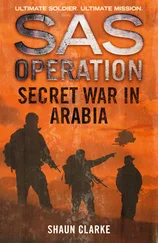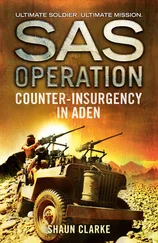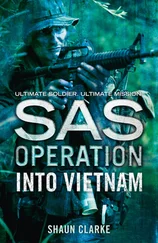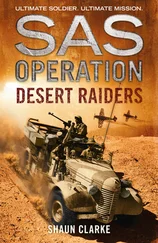‘More dust, heat, flies and mosquitoes,’ Dennis the Menace said. ‘Welcome to Paradise!’
‘You know why these barracks are raised off the ground, don’t you?’ Pete Welsh asked rhetorically, having the answer all prepared. ‘Because this place is crawling with scorpions, centipedes and snakes, every one of ’em poisonous.’
‘It’s crawling with everything except women,’ Boney Maronie said, ‘which is why they should have given us at least one night out in Penang. I think I’m getting ready to explode. I’ll drench the whole fucking ceiling.’
‘Boasting again,’ Dennis the Menace said. ‘You haven’t really got it in you. But that obstacle course out there looks like hell. A few runs over that fucker and you’ll soon get rid of all your excess energy. By the time you’ve finished, you won’t remember what a woman is, let alone what she feels like.’
‘Tree-jumping,’ Dead-eye said. ‘That’s what bothers me. Those trees are 150 feet high and pretty damned dense. I don’t fancy climbing those with a bergen, rifle and knotted rope, let alone parachuting into them.’
‘Piece of piss,’ Pete Welsh said, his grin making him look slightly crazy. ‘You just spread your legs and get spiked through the balls by the top of a tree. If you miss that, you crash down through the branches and get all smashed to hell. Failing that, you snag your chute on the branches and possibly hang yourself. Sounds like a joyride.’
‘I can’t wait,’ Alf Laughton said.
Once settled in, the men were gathered together in the briefing room, given a brief lecture on the history and habits of the jungle natives, told not to call them ‘Sakai’, which meant ‘slave’, and informed that they would be receiving a two-hour lesson in the native language every day. The first such lesson began immediately and was very demanding.
When it had ended, at 10 a.m., the men were allowed a ten-minute tea break, then marched to the armoury, where they were given a selection of weapons, including those fired on the range of Minden Barracks: the M1 0.3in carbine, the 9mm Owen sub-machine-gun, the 7.62mm semi-automatic SLR and the Browning 9mm High Power handgun. They were also given a Fairburn-Sykes commando knife and a machete-like parang .
Having already tested the men’s skills on the range at Minden Barracks, Sergeant Lorrimer knew precisely who was best at what and distributed the weapons accordingly, with the Owen sub-machine-guns going to those he was designating as scouts, or ‘point men’, in his patrols.
‘Here,’ he told the men assembled outside the armoury in the already fierce heat, ‘you won’t have to sign the weapons in and out. Instead, you’ll keep them with you at all times, either on your person or in your lockers. If any man loses a weapon or ammunition he’ll be RTU’d instantly.’
From that moment on, though the men were trained together, they were broken up into four-man teams, first devised by David Stirling in World War Two as a means of combining minimum manpower with maximum surprise. The four-man team was deemed to be the most effective because members could pair up and look after each other, both tactically and domestically, sharing duties such as brewing up, cooking meals, erecting shelters or camouflaging their position. Also, soldiers have a natural bonding instinct and divide into pairs to tackle most tasks.
Though every member of the four-man patrols had been trained in signals, demolition and medicine, and was presently learning the rudiments of the local language, each individual had to specialize in one of these. Trained to Regimental Signaller standard in morse code and ciphers, the team’s specialist signaller was responsible for calling in aerial resup (resupply) missions, casevac (casualty evacuation) and keeping contact with base. While all of the team had been trained in demolition, the team’s specialist in this skill was responsible for either supervising, or carrying out, major sabotage operations. The job of the language specialist was to converse with the locals, on the one hand gaining their trust as part of the hearts-and-minds campaign, on the other gleaning from them whatever information he could. The specialist in medicine would not only look after the other members of his patrol, but also attempt to win the trust of the locals by treating them for stomach pains, toothache, tuberculosis, malaria, scurvy or any other illnesses, real or imagined.
‘Though the basic unit will be the four-man team,’ Captain Callaghan told them when they were kneeling in the dirt at the edge of the sports ground, in the murderous heat, assailed constantly by flying insects, ‘we have three different kinds of patrol here. First is the reconnaissance patrol, usually a four-man team, which is tasked with observation and intelligence gathering, including topographical info; the selecting of sites for RVs, helicopter landings and good ambush positions; location of the enemy; and the checking of friendly defences, such as minefields. Second is the standing patrol, which can be anything from a four-man team to a troop or more. The standing patrol provides a warning of enemy advance and details of its composition, prevents enemy infiltration and directs artillery fire or ground-attack aircraft on to enemy positions. Finally, we have the fighting patrols, composed of either two four-man teams or an entire troop, depending on the nature of the mission. The job of the fighting patrol is to harass the enemy; conduct raids to gain intelligence or capture prisoners; carry out attacks against specific targets; and prevent the enemy from obtaining info about friendly forces in a given area. Sooner or later, each of you will take part in all three types of patrol. First, however, you’ll undergo a weapons training programme more rigorous than anything you’ve imagined in your worst nightmares. They’re all yours, Sergeant Lorrimer.’
Callaghan was not exaggerating. While the normal SAS training programme was the most demanding of any in the armed forces, even that had not prepared the men for the merciless demands that were now placed upon their physical stamina and skill. They were called upon not only to perform target practice in the scorching heat while being assailed by bloated flies, kamikaze mosquitoes and a host of other insects driven mad by the smell of human sweat, but also to carry out numerous tactical movements designed to meet the special requirements of jungle warfare.
Thus, when Sergeant Lorrimer was satisfied that each man had proven himself a crack shot, he moved on to lessons in the actions and drills to be carried out in case of contact with the enemy, the proper order of march when in the jungle, the silent signals required when changing formation, the various drills for encounters with natural and man-made obstacles, and, most important, the Head-On Contact Drill.
‘The HOCD,’ he explained as they were getting their breath back after an exhausting ‘shoot and scoot’ exercise, ‘is the Standard Operating Procedure, or SOP, devised specially for four-man patrols on the move. When contact is made with the enemy, each member of the patrol will move instantly into a position that allows him to open fire without hitting a comrade. You four,’ he said, jabbing his finger at Dennis the Menace, Boney Maronie, Dead-eye Dick and Alf Laughton. ‘Stand up.’
‘Jesus, boss,’ Dennis the Menace complained as he wiped the sweat from his sunburnt face, ‘we’ve just sat down for a so-called break.’
‘The break’s over, so get to your feet.’ When the foursome were standing at the edge of the sports ground, near one of the deep monsoon drains, Lorrimer made them move into position to demonstrate a particular HOCD. He placed Dead-eye well away from the others, at the front as lead scout. Pushing the others closer together as carelessly as if they were shop-window dummies, he said: ‘So! If the patrol is moving in file, these three men behind the lead scout will break left and right as they bring their weapons to bear on the enemy… Break, damn it ! Break !’
Читать дальше
